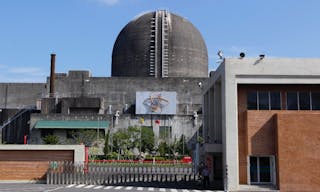What you need to know
Simultaneously achieving the two goals will be a big challenge.
By Tim Ferry
Nuclear power, which by law is due to be phased out entirely by 2025, has dropped to less than 6 percent of total power generation in Taipower’s grid. With four out of six reactors offline — two because of Legislative Yuan reluctance to approve the resumption of operations after incidents, one due to lack of spent-fuel storage, and the fourth temporarily for refueling — Taiwan is at its lowest use of nuclear power in decades.
That may be good news for Taiwan’s adamant no-nukes crowd, but it’s not so good for carbon emissions reductions. To replace the lost nuclear power, Taiwan has had to turn to fossil fuels, whose share of power generation has risen to 90 percent.
On April 10, when Taiwan saw the temperature climb to 35°C, coal generated 40.5 percent of total power, LNG 39 percent, fuel oil and diesel 8.2 percent, with another 2 percent from private co-generation sources (mostly coal), according to the Taipower website. Renewables generated some 4.6 percent, and nuclear 5.4 percent. That same day, power demand rose to record highs and reserve power capacity dropped below 6 percent, prompting Taipower to issue an orange alert indicating tight supply margins, only the second time such an alert has been issued in the month of April (the first time was in 2016).
By comparison, in 2014 nuclear accounted for 19 percent of power generation and fossil fuels for 78 percent, with reserve margins at around 15 percent.
On April 13, the government announced an ambitious NT$36.5 billion (US$1.2 billion) effort to clean up Taiwan’s air, which has noticeably deteriorated. At a press conference, Premier Lin Chuan noted that it is difficult to pinpoint the exact sources of air pollution. However, the Environmental Protection Administration has estimated that the energy sector is responsible for some 89 percent of emissions.
The government touts the introduction of more-efficient ultra-supercritical units in several power plants and increased reliance on plants burning natural gas, but while such units are less polluting, they nevertheless emit tons of CO2.
The obvious solution is renewable energy. So far, wind and solar comprise negligible amounts of Taiwan’s power generation, less than 1 percent each, but the administration has ambitious goals to change that. It aims to have 20GW of solar installed capacity by 2025. Of the initial 1.4GW of installed capacity planned for mid-2018, not a single such project is under construction or has even been approved. The reason? Many of the potential sites are salt marshes that provide crucial habitats for rare migratory birds, particularly the black-faced spoonbill.
It’s a painful contradiction with no ready solution. Should landscapes that support endangered species be sacrificed for renewable energy, which is being deployed primarily for climate change mitigation — the purpose of which, in part, is to reduce biodiversity loss?
Compromises can surely be hammered out, but in the meantime, emissions continue to rise, and CO2 emissions remain in the atmosphere anywhere from 20 to 200 years. The short-term remedy would, of course, be to restart nuclear reactors that have been idled due to political opposition. Jinshan (NPP1) reactor 1 and Kuosheng (NPP2) reactor 2 both experienced incidents — in December 2014 and May 2016 respectively — that forced them to shut down for repairs. Both reactors have been repaired to the satisfaction of the Atomic Energy Council (AEC), but the legislature has blocked their restart.
Reactor-1 at Kuosheng has also been shut down since November last year when it maxed out its spent fuel storage pools. Taipower has a plan to get around the problem by converting a loading pool into a spent fuel storage facility. The conversion plan, which has been approved by the AEC after an 11-month review, would create enough spent fuel storage capacity for the reactor to be refueled and restarted by July, which would help with the summer peak demand.
But legislators from the New Power Party have objected that the project was done in an opaque manner and ignores the will of the public. Taipower responded that it held several town halls about the project and that even some environmental NGOs have recognized the need for the construction and eventual restart of Kuosheng-1.
Yet even this construction would only enable the Kuosheng-1 unit to run for two more fuel cycles, not enough to carry it to the end of its licensed lifecycle in 2021. Meanwhile, Jinshan’s single operating reactor will shut down next month as its spent fuel pools likewise will be filled to capacity. The Jinshan facility is scheduled for retirement in December 2018.
Assuming that New Taipei City doesn’t rescind its ban on dry cask storage, which would enable enough space to be cleared in the cooling pools to allow the reactors at Jinshan and Kuosheng to be refueled, Taiwan’s options are scant. One possibility is for the construction of Kuosheng’s loading pools to allow this reactor to restart, while also restarting the reactors that remain offline due to political interference. Due to the lack of spent-fuel storage capacity, all of these reactors would still be unable to operate until their original decommissioning dates, but they would at least provide some relief from spiraling emissions.
Beyond that — until renewables can take up a major portion of Taiwan’s energy mix — the Taiwan public may have to decide between discontinuing nuclear power on schedule and the prospect of worsening air quality.
The News Lens has been authorized to repost this article. The piece was first published by Taiwan Business TOPICS.
(Taiwan Business TOPICS is published monthly by the American Chamber of Commerce in Taipei.)
TNL Editor: Edward White



